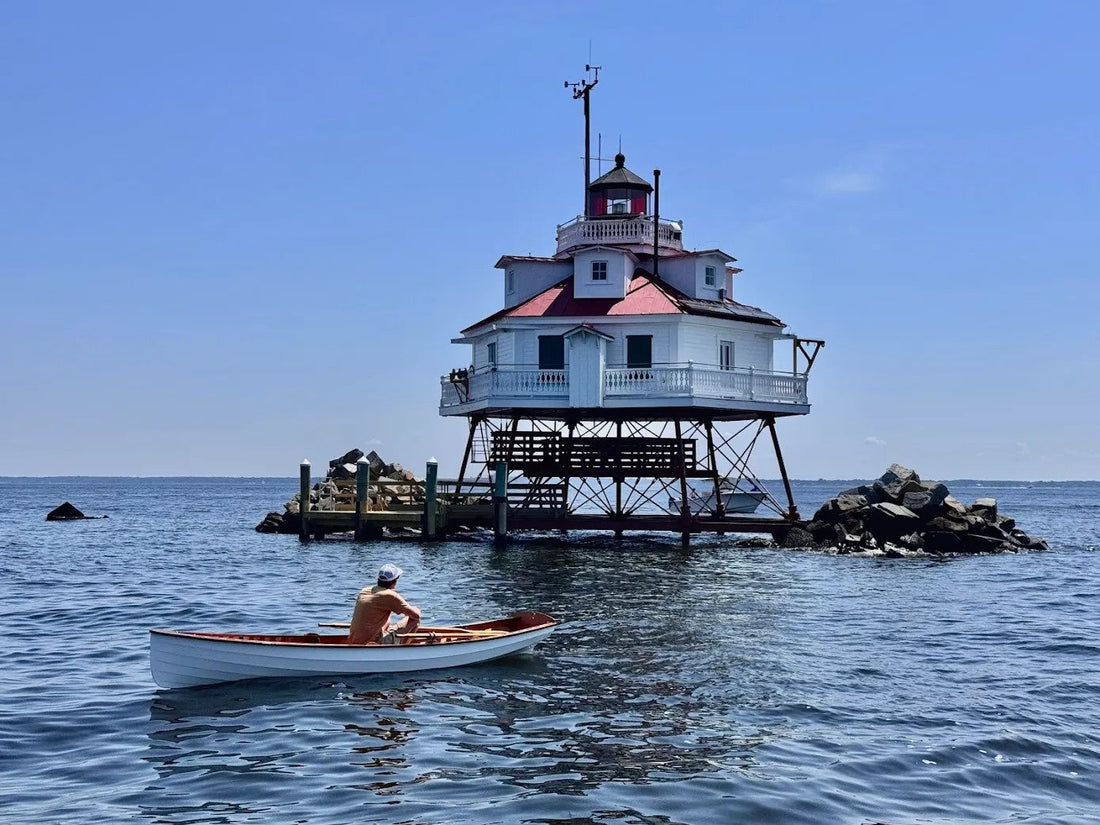
Sail to the Lighthouse (Just Messing About in Boats!)
by John C. Harris
June 2025
Naming a new boat is never easy. The name should be memorable, of course, and resonate with the boat’s history, spirit, or intended use. When I designed CLC’s Maine-style peapod kit, I was stumped for a name until I turned to one of the classics: American Small Sailing Craft by Howard Chapelle. This timeless reference catalogues the working boats of early America, and among them, the “Washington County Peapod” spoke to me most. Chapelle noted that the Washington County types were once used to tend lighthouses, among other utilitarian chores. That'll do! And thus we have the Lighthouse Tender Peapod.
There was a nice alignment of stars when John Potvin—a longtime small boat enthusiast and the manager of the historic Thomas Point Shoal Lighthouse—decided to build his own Lighthouse Tender Peapod. Thomas Point, a Chesapeake Bay icon, is celebrating its 150th anniversary this year. Among the commemorative events, John organized a low-key gathering of small traditional boats to sail out to the lighthouse and back. It was the perfect homage. For its first 50 years, and probably longer, small rowing craft like peapods, dories, and skiffs would have tended Thomas Point Shoal Lighthouse, ferrying crew and supplies in all weathers, year-round. (Thomas Point remained a crewed lighthouse until 1986, when it was automated.)
Last Saturday’s event was a perfect example of that most charming of nautical pastimes: the small-boat “messabout.” The concept of a "messabout" can be traced back to an immortal line in Kenneth Grahame's book, The Wind in the Willows.
Ten boats appeared on the beach last Saturday morning, nine of them wooden rowing-sailing craft from CLC's catalog. Four of them, happily, were Lighthouse Tender Peapods, joined by three Northeaster Dories, one Skerry, and one Chester Yawl.
Light wind and a flooding tide kept most of the fleet from reaching the lighthouse itself—except for the Chester Yawl, which covered the two nautical miles out to Thomas Point Light and back in a jiffy, under oar power alone. The rest of the fleet had to settle merely for having enjoyed a nice sail and the fellowship of boat nerds. From one of the chase boats, I got to revel in the sight of so many traditional smallcraft being enjoyed exactly as intended. And I even made it to my daughter's dance recital on time.
Enjoy this gallery of snapshots, captured by Will Keyworth, David Sites, James Ronayne, John Potvin, and myself. Special thanks to John for organizing a wonderful day on the Bay, and for keeping the spirit of small traditional boats alive at one of its most storied lighthouses.
 The fleet lined up on the beach on Saturday morning, June 21st, 2025.
The fleet lined up on the beach on Saturday morning, June 21st, 2025.
 From the left, a Lighthouse Tender Peapod, a Northeaster Dory, and a Skerry. Three different and worthy approaches to the 50/50 rowing-sailing boat design brief.
From the left, a Lighthouse Tender Peapod, a Northeaster Dory, and a Skerry. Three different and worthy approaches to the 50/50 rowing-sailing boat design brief.
 Two great shots of the Lighthouse Tender Peapod herself, slipping along beautifully in light air.
Two great shots of the Lighthouse Tender Peapod herself, slipping along beautifully in light air.
 A Northeaster Dory with a terrific finish scheme. Back when dories were among the most common smallcraft on the waterfront, whimsical and colorful paint jobs were popular!
A Northeaster Dory with a terrific finish scheme. Back when dories were among the most common smallcraft on the waterfront, whimsical and colorful paint jobs were popular!
 Match-racing in lug-rigged Peapods.
Match-racing in lug-rigged Peapods.
 The fleet short-tacking out of Fishing Creek, south of Annapolis.
The fleet short-tacking out of Fishing Creek, south of Annapolis.
 A lug-rigged Northeaster Dory in perfect trim.
A lug-rigged Northeaster Dory in perfect trim.
 A Chester Yawl under oars, a Skerry under sail, and the Thomas Point Shoal Lighthouse in the hazy distance.
A Chester Yawl under oars, a Skerry under sail, and the Thomas Point Shoal Lighthouse in the hazy distance.
 For "VMG" between Fishing Creek and the lighthouse, oars proved the best propulsion method on this particular day. In 1875 and for a good 50 years after—until the advent of reliable power boats—small rowing craft like this Chester Yawl would have been the primary method of transport to and from the lighthouse, in all weather!
For "VMG" between Fishing Creek and the lighthouse, oars proved the best propulsion method on this particular day. In 1875 and for a good 50 years after—until the advent of reliable power boats—small rowing craft like this Chester Yawl would have been the primary method of transport to and from the lighthouse, in all weather!
 We'll have many more spontaneous small boat messabouts in years to come!
We'll have many more spontaneous small boat messabouts in years to come!